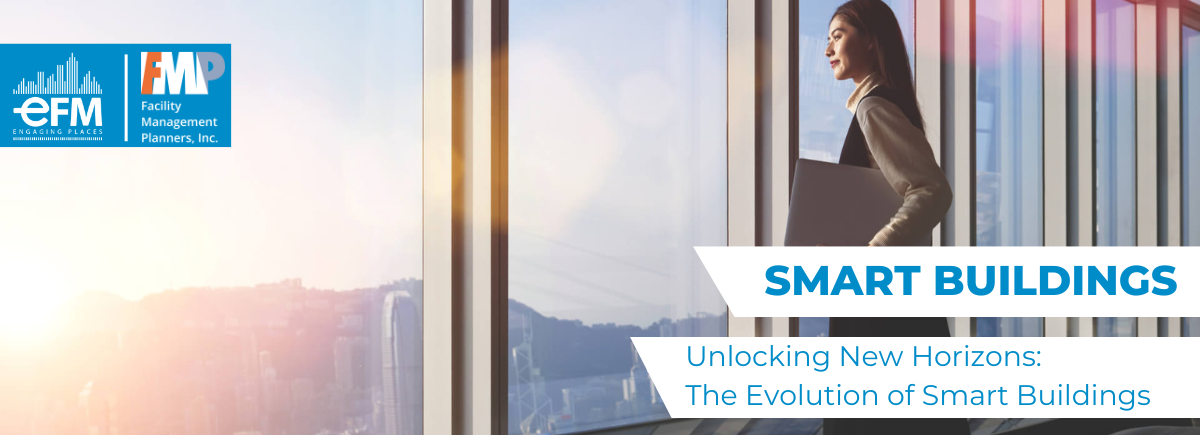
Unlocking New Horizons: The Evolution of Smart Buildings
On Apr 1, 2024
The concept of smart buildings isn’t new; it dates back at least 40 years, although it was previously referred to as “intelligent buildings.” What makes it particularly relevant today is the integration of two closely intertwined factors which influence its characteristics and development trajectories. The first factor is digital transformation, encompassing a spectrum of applications from the household-level like smart home systems to corporate environments like digital workplaces and Digital Twins—digital replicas of the building facilitating sophisticated facility management processes; a concept which can be expanded beyond individual buildings to encompass entire smart cities, where various information and services are interconnected and integrated to improve efficiency and quality of life. The second critical factor arises from the emergence of the post-pandemic landscape, prompting a reassessment of work models and necessitating the implementation of compliance policies in line with social distancing regulations.
The Crucial Role of IoT in Smart Buildings
Certain technologies, particularly those within smart environments like smart buildings, will dominate in the coming years. At the forefront are IoT (Internet of Things) devices and architectures, ranging from intelligent management of lighting, HVAC systems, and predictive maintenance to workspace management. This disruptive phenomenon in real estate enables and revolutionizes the concept of building and city utilization towards a “space-as-a-service” model. According to Forbes, by the end of 2024 there are projected to be more than 207 billion devices connected worldwide. As of 2023, the global Internet of Things (IoT) market was estimated at more than $595 billion and is anticipated to reach over $4,000 billion by 2032, a growth rate exceeding 24%.
The Boom of Remote Work: Navigating Misleading Perceptions
With a particular focus on video surveillance systems and energy consumption management within buildings, industry research highlights the comprehensive and articulated nature of smart building approaches. The exponential increase in smart working between 2020 and 2021, from around 11 million to over 27 million workers in the U.S. alone, has led to what can be termed as ‘false positives.’ On one hand, there was speculation that remote work might permanently empty offices and corporate spaces; on the other, it was also looked at as a temporary trend expected to fade with the end of the pandemic. While innovations such as space optimization, health-focused access control, and virtual receptions may face scrutiny about their necessity post-pandemic, a complete return to pre-pandemic work patterns seems unlikely. An intriguing prospect emerges with the concept of shifting from headquarters to ‘Hubquarters,’ where companies can curate hubs of experiences and rejuvenate spaces emptied by the pandemic.
Smart Buildings at the Core of Employee Empowerment
The evolving reality is that smart buildings will play a central role in fostering employee empowerment, with a focus on enhancing productivity and well-being beyond traditional workplace boundaries. Whether employees work remotely, in-office, outdoors, or in shared coworking spaces, they should have seamless access to a digital workplace environment. Facility managers will face the task of customizing smart office spaces to ensure safety, flexibility, and effective access monitoring. Moreover, they will need to develop strategies to track individual behavior and engagement levels in specific locations. This transition means that by utilizing data aggregation platforms with IoT devices, the employee experience can be enhanced through a shift away from traditional building-centric methods towards more human-centered environments.
Embracing the Future: Smart Buildings Redefining Workplaces
In an era of constant change, smart buildings stand as beacons of workplace innovation, reshaping the way we perceive and interact with our work environments. From fostering employee empowerment to optimizing efficiency and safety, the journey towards smart buildings is one of continuous evolution and adaptation. By embracing this forward-looking approach, organizations can unlock new opportunities, creating workplaces that not only meet the needs of today but also anticipate the challenges of tomorrow. Let’s embrace this transformation together and pave the way for a smarter, more connected future.